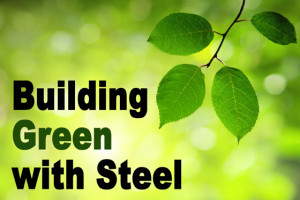Environmentally Responsible Buildings for Industry
We covered some of the business benefits of constructing steel industrial buildings in the two previous blogs. (See “7 Reasons to Choose Steel Industrial Buildings” and “7 More Reasons to Choose Steel Industrial Buildings.”)
 But what about the environmental impact of using steel framing for industrial construction?
But what about the environmental impact of using steel framing for industrial construction?
Is steel a green, eco-friendly choice?
Absolutely!
Recycling Steel
Consider these steel facts:
- Steel is by far the most recycled material on the planet.
- Steel is 100% recyclable.
- Recycling steel reduces greenhouse emissions.
- More style is recycled every year than aluminum, glass, paper, and plastic all combined.
- Today 100% of junked cars— and 80% of all major appliances— are recycled into new steel.
- Steel’s magnetic qualities make it simple to separate, handle, and recycle. Elector-magnets suck the steel right out of the mixed solid waste. The aluminum, glass, paper, and plastic left behind must be painstakingly sorted by hand.
- Steel is the only material that can be recycled repeatedly without losing any strength.
- The steel industry has actively recycled iron and steel scrap for over 150 years.
- A 20,000 sq. ft. steel industrial building contains the equivalent of about 60-70 scrapped cars. Construction a building the same size with wood would consume 10 acres or more of forest.
- A Douglas fir takes 80-125 years to reach 18” in diameter. Even fast-growing tree species need 30-35 years to reach harvestable size. Only 2 man-hours are required to produce one ton of steel.
- The steel framing for RHINO metal industrial buildings contain up to 90.7% recycled steel.
Air Quality and Steel
- Using recycled steel significantly lowers greenhouse emissions.
- Recycling steel reduces mining wastes by 97%, lowers air pollution 86%, and cuts water pollution by 76%, compared to producing new steel.
- Lumber and engineered wood products out-gas, polluting the atmosphere and affecting indoor air quality. Steel does not out-gas.
- Wood is organic and feeds mold. Inorganic steel does not support mold growth.
- Lumber and engineered wood products require harsh chemical treatments to combat termites and wood ants. Steel does not attract termites or vermin.
Energy Efficient Steel Industrial Buildings
- Buildings consume 73% of all electricity used in the U.S.
- The deeper wall cavities of metal industrial buildings provide room for thicker, more energy-efficient insulation.
- RHINO’s Pro-Value insulation system slashes a building’s energy consumption in half.
The Lifecycle of Metal Industrial Buildings
- Steel buildings last decades longer than wood-framed structures. Consequently, buildings need to be replaced less often, conserving resources.
- When steel industrial buildings reach the end of their usefulness, the steel is sold for scrap, to be recycled and reborn again as new steel.
- Wood framing winds up in dump at the end of its lifecycle, further crowding overflowing landfills.
Steel Industrial Buildings: Better for You and Better for our Planet
Building with steel has never been easier. Choose a RHINO-tough steel industrial building for your next project. An experienced RHINO metal building specialist will provide you with more information and a free quote.
Call us at 940.383.9566.
